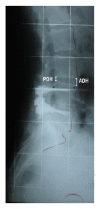PEEK versus Silicon Interspinous Spacer for Reduction of Supradjacent Segment Degeneration following Decompression and Short-Segment Instrumentation for Degenerative Lumbar Spinal Stenosis
- PMID: 30174959
- PMCID: PMC6106718
- DOI: 10.1155/2018/1623647
PEEK versus Silicon Interspinous Spacer for Reduction of Supradjacent Segment Degeneration following Decompression and Short-Segment Instrumentation for Degenerative Lumbar Spinal Stenosis
Abstract
Purpose: A retrospective study that aims to report Adjacent Segment Degeneration (ASD) incidence and spinopelvic balance in short lumbosacral instrumentation for degenerative lumbar spinal stenosis. Although ASD is a common complication following lumbar fusion, the effect of an interspinous spacer (IS) in the supradjacent segment in short lumbosacral instrumented fusion and its interaction with spinopelvic balance has not been studied adequately.
Methods: From 55 consecutive age-, diagnosis-, and gender-matched patients aged 60±11 years, 17 (Group R) received PEEK IS; 18 (Group S) received Silicon IS compared with 20 controls (Group C) without receiving any IS. The functional outcome was evaluated with VAS and ODI. Spinopelvic balance was evaluated using SVA, T12-S1 LL, SS, PT, PI, and supradjacent segment disc heights. All spines were preoperatively balanced (SVA<40 mm).
Results: The follow-up averaged out to 56±11 months. VAS and ODI scores improved postoperatively in all 3 groups. SS and anterior disc height in the supradjacent free segment increased postoperatively compensatory to spinal alterations. Although 6, 4, and 5 patients from Groups R, S, and C, respectively, showed radiological progression of the preoperative degeneration grade in the supradjacent disc, only 2, 1, and 2 patients in Groups R, S, and C, respectively, developed symptomatic ASD in the 1st supradjacent segment solely. No additional surgery was required in any patient.
Conclusion: ASD incidence in the supradjacent segment following short lumbar fusion did not statistically significantly differ between PEEK and Silicon IS. There was a trend towards lower ASD incidence in Silicon IS. IS reduced ASD in both 1st and 2nd supradjacent segments. The authors speculate that soft stabilization provided by IS may be more advantageous for preventing ASD. This trial is registered with ClinicalTrials.govNCT03477955.
Figures





References
-
- Lee C.-H., Hyun S.-J., Kim K.-J., Jahng T.-A., Yoon S. H., Kim H.-J. The efficacy of lumbar hybrid stabilization using the DIAM to delay adjacent segment degeneration: an intervention comparison study with a minimum 2-year follow-up. Neurosurgery. 2013;73(2):224–232. doi: 10.1227/neu.0b013e31828e8ddc. - DOI - PubMed
Associated data
LinkOut - more resources
Full Text Sources
Other Literature Sources
Medical
Research Materials
Miscellaneous

